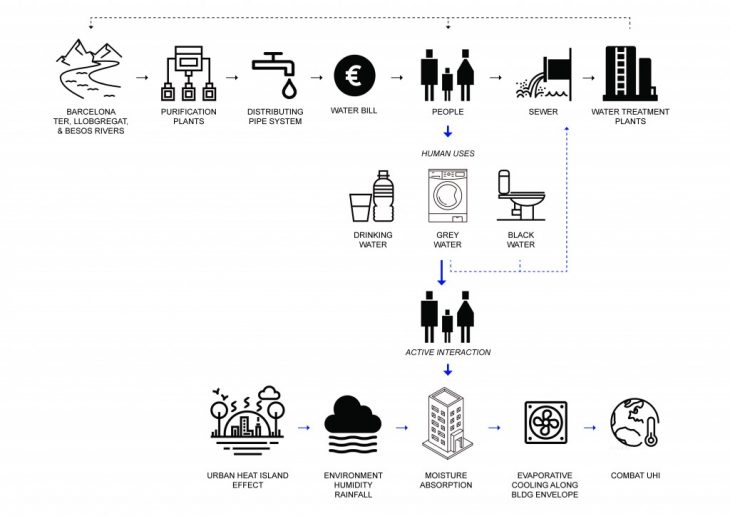Our project aims at using IaaC’s envelope for evaporative cooling to lower the temperature both inside and outside of the building and to combat urban heat island effect. Our project is focused on the effects of urban heat island effect in the city of Barcelona. Urban heat island effect occurs in urbanized areas and it is an increase in temperature compared to the surrounding rural areas. There are multiple causes for this condition. The main cause is the lack of permeable surface which prevents the heat from being absorbed into the ground and traps the heat in the city, this occurs from a lack of green spaces. This is a major problem in Barcelona specifically as the city is below the World Health Organization’s limit for green spaces. Pollution and engine heat from cars also contribute to the rise in temperature in urban settings. In our research we discovered that two neighborhoods in Barcelona which have heavier traffic surpass the European Union’s NO2 limit. Poblenou, where IaaC is located, is right on the limit indicating that it could easily increase and needs to be monitored. Building heights also impact urban heat island effect as their height restricts wind from passing through and cooling the area. The buildings in Barcelona contribute to this factor as 59% of structures in the city are considered high-rise. Building equipment, lighting and occupants all create heat that is given off from buildings and add to temperature increases in the city.

After studying urban heat island effect we looked into ways to combat it. Our initial research and analysis led us to the use of humidity as we discovered that the humidity in Barcelona is consistently high throughout the year. We decided to utilize this humidity for evaporative cooling as Barcelona is in a suitable region for this method. Through our experimentations we discovered that a thin mesh would be most successful in capturing humidity from the air. Tighter mesh works better to collect water from the air and more joints allow the captured humidity to condense into droplets and move quicker through the mesh. From further experiments we came to the conclusion that a combination of a thin mesh layer, backed with hydrogel would work best to capture humidity from the air and store for evaporative cooling. Hydrogel expands as it absorbs water, that water is stored and later released into the air for cooling. We would apply the mesh and hydrogel panels to the inside and outside of the Iaac façade. Our project would also use recycled greywater from the building when humidity does not provide enough water for cooling. The greywater would pass through a UV purifier and then flow through pipes to the façade where the recycled water would seep into the panels for an extra cooling effect.
Our project aims to create a sustainable cooling solution for both the IaaC building and the city of Barcelona through the use humidity and recycled greywater. Urban heat island effect is not an issue that affects only Barcelona, it is a global issue and our project could be used to cool cities around the world.
Students: Jennifer Li, Hannah Mitchell, Mira Tihova
Faculty: Mathilde Marengo
Teaching Assistant: Johana Monroy